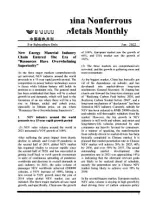MIIT: Focus of Nonferrous Metal Industry Shift to Recycling
2011-08-15
MIIT: Focus of Nonferrous Metal Industry Shift to Recycling
According to experts,in the 11th five year plan,China's total nonferrous metal output increased significantly,with the increasing proportion of secondary nonferrous metal output.Technology,equipment,energy conservation and environmental protection capabilities have kept improving.Metal melting recovery rate and product mix have also seen great improvements.The industry has experienced rapid development.
In the first four years of the 11th fiver year plan,the secondary nonferrous metals industry in China,if compared to generating the same amount of primary metals,saved 46.5 millions of standard coal and 1.88 billion cubic meters of water,and reduced the solid waste by 3.45 billion tons and sulfur dioxide emissions by 1.12 million tons.
China’s nonferrous metal mineral resources are relatively in shortage,while energy consumption keeps increasing.Key resources are highly dependent on import.65% of copper raw material,55% of aluminum and 30% of lead and zinc are imported.The trend is expanding.This stimulates the development of Chinese secondary nonferrous metals industry.
Liu Wenqiang,director of General Affairs Division of Department of Integrated Utilization,MIIT stated that statistics shows that compared with primary metal production,generating one ton of secondary lead can save 659 kg standard coal and 235 cubic meters water,and reduce 128 tons solid waste and 0.03 ton sulfur dioxide emissions.It is evident that secondary nonferrous metals industry has become an important part of Chinese nonferrous metals industry.Currently,Chinese nonferrous metal recycling is still at the initial stage of development.In the Promotion of Secondary Nonferrous Metals Development Plan,by 2015,the output of secondary nonferrous metals in China will reach 12 million tons,among which secondary copper,aluminum and lead will account for 40%,30% and 40% of the copper,aluminum and lead outputs of the year respectively.
By 2015,Chinese secondary copper industry and aluminum industry will see some big players with the annual production capacity of over 100,000 tons,and enterprises with the annual capacity of over 50,000 tons will emerge in the secondary lead industry.Top 10 enterprises will take over 50% of the market share.In some key areas with industrial clusters,the production capacity will exceed over 80% of the industry.
MIIT stressed that in addition to appropriate adjustments to the distribution in the coastal areas,there will be no new nonferrous metals dismantling processing parks in principle.
On the current basis,it is expected to see 5 processing parks with the annual dismantling capacity of over 1 million tons and 10 parks with the annual capacity of 500,000 tons,5 recycling markets with the annual trade volume of over 600,000 tons and 10 recycling markets with the annual trade volume of over 400,000 tons.
Moreover,China will develop the market access conditions in the secondary copper,aluminum and lead industries to clarify access indices on business scale,technology and equipment,integrated power consumption and environmental protection in order to lift the market access threshold,promote technical transformation and industrial restructuring,control total output and prevent low-level redundant construction and blind expansion.
